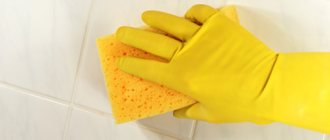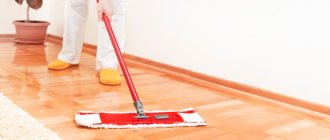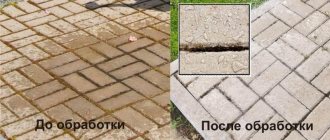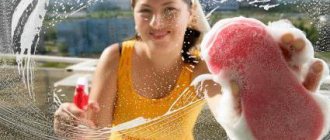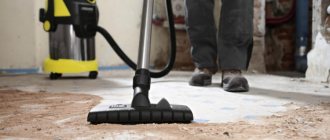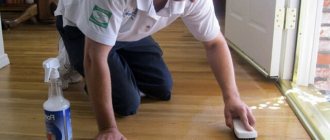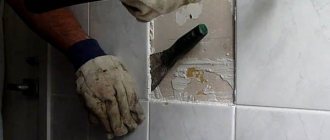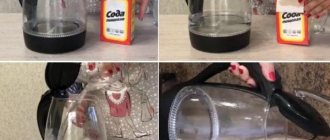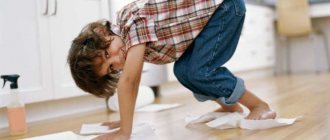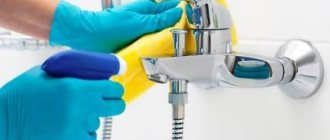Everyone faces repairs sooner or later. How to clean tiles after renovation? Many owners ask this question after completing renovation work.
The most unpleasant part is cleaning, especially cleaning the tiles from various contaminants.
Fresh stains and dirt can be easily removed with a wet rag. But if this is not done right away, the remaining building materials dry out and are more difficult to remove. Tiles and ceramic tiles are very dense and resistant to aggressive substances.
Getting rid of construction dust
It is not difficult to clean tiles from construction dust after renovation. To do this, you will need a soft cloth and warm water. The tiled surface will have to be washed several times, so get ready for this right away. And do it this way: wash the tiles with a rag and plain water, wait until it is completely dry.
What is the price for removing old paint from walls? Repeat the process until you get the desired result. Usually, for absolute cleanliness, changing the water 2-3 times is enough.
When contaminated with construction dust, it doesn’t really matter what material you wash – ceramic tiles on the wall in the bathroom or kitchen, or porcelain tiles on the floor. In any case, water is the best helper.
Important! To speed up the process and get excellent results, use a liquid cleaner that you add to the water. The most famous of this line of household chemicals is Mister Proper.
You don't even need to wash it off.
If dust gets stuck in the seams between the tiles, use a toothbrush. With its help, you can efficiently clean hard-to-reach areas.
How to properly clean tiles after renovation
Ceramic tiles or just tiles in a modern interior are an irreplaceable material, because... practical, easy to clean and beautiful, gives the room a finished, neat look. The only thing that can be very upsetting is the contamination of the tiles after repairs.
Depending on the raw material, the surface may react to the chemical composition of the surface being treated, or may be indifferent to the action of aggressive agents. Clinker tiles are formed by extrusion or wet pressing, and then fired for a long time at high temperatures. Porcelain tiles are produced using the semi-dry pressing method and, just like clinker tiles, porcelain tiles are fired at high temperatures.
We invite you to familiarize yourself with the concept of shelf life and the difference from expiration date.
You can thoroughly clean tiles after repair using either a homemade or purchased solution.
After repairs, unfortunately, the tiles can become dirty, and the dirt can be such that it cannot be washed off with ordinary soapy water. Sometimes a very pressing question arises: how to clean tiles after renovation?
Methods for cleaning tiles:
- The frozen adhesive solution is moistened with water in which vinegar or ammonia is dissolved, then mechanical forces are applied using any auxiliary equipment, for example, a spatula, scraper, screwdriver, etc., or solvent-based chemicals are used.
- The absorbed primer is washed off with special products that contain solvents, acetone, or you can use a fresh primer, then simply clean it off with auxiliary tools.
- If the tiles are contaminated with cement grout, lime or plaster, you can simply wash it off with water, but for epoxy grout you will have to buy a special epoxy solvent.
- Construction dust and putty can first be removed with a dry cloth or vacuum cleaner, and then it is suggested to wash it simply with water or soapy water, water with lemon, vinegar or glass cleaner.
- Silicone sealant or paint can be removed mechanically or using solvents based on acetone or white spirit.
Successful cleaning of tiles consists of correctly identifying the type of contamination, the surface layer of the tile itself and using the appropriate product, but the best way to clean all types of tiles is to protect them before repairs or timely removal of contamination.
Washing the paint
With paint the situation is more complicated. The easiest way to deal with fresh marks: if you accidentally get paint, you should quickly wipe it off with a soft cloth, and that’s it. If you hesitate, it won’t be so easy to wipe off dried paint from tiles or porcelain tiles.
Although, of course, there are ways. Here they are:
- Stains from water-soluble paint should be thoroughly moistened and then washed off.
- Fresh traces of oil paint can be removed with vegetable oil.
- Old paint stains can be removed from tiles using a solvent. To clean floor tiles from stains, first try removing them mechanically - with a blade, felt or sandpaper, and then wash them with plain water with the addition of dish gel.
Additional Helpers
Various chlorine products help to thoroughly clean tile surfaces from dirt. To do this, apply a bleach solution from a spray bottle onto a damp tile, wait a few minutes and rinse with water.
A well-known household stain remover, ammonia, can also be used to clean tiles and porcelain tiles. To do this, dissolve 2 tablespoons of ammonia in a liter of water and begin cleaning. Particularly noticeable stains will need to be rubbed thoroughly.
How to cover a wooden chair after removing the old paint? After ammonia treatment, the tiles look very attractive - there are no streaks left on them, and a shine appears.
The final cleaning of the tiles after repair is carried out after removing all kinds of stains. We invite you to get acquainted with the methods used by the older generation. The peculiarity of our grandmothers’ products is their budgetary availability and the complete absence of aggressive chemicals.
Let's shine
We will use only environmentally friendly materials:
- Laundry soap.
- Vinegar or citric acid.
- Baking soda.
When choosing laundry soap, you should wash the tiles with the prepared soap solution. To do this, rub laundry soap and dissolve it in clean water. For washing, use a soft cloth, sponge or microfiber cloth.
A vinegar solution will help add shine and newness. Calculation of the product - 2 tablespoons per 500 ml of water. After you wash off the soap, wipe the tile with “sour” and it will shine. Vinegar can be replaced with citric acid.
The result will be the same, but it smells nicer. More precisely, it doesn't smell at all.
Baking soda is indispensable as a detergent. It removes small and large stains, helps dissolve grease, and makes the tiles practically new. For regular washing, a 2% soda solution is enough, but for washing after repairs it is better to do this:
- Moisten the tiles well before cleaning them after repair.
- Clean it with dry soda applied to a sponge, rags, etc.
- Dip a damp toothbrush into dry baking soda and scrub the seams.
- Afterwards, rinse everything off with clean water.
During routine cleaning, it is good to wash tiles with window cleaners. They are easy to spray and give excellent results. In principle, all solutions that are used to wash glass are also suitable for tile coverings.
There is no difference for glossy and matte finishes.
Now a little about cleaning materials. Microfiber, bamboo napkins, sponges in all variations are closely involved in this process. We advise you to pay attention to melamine sponges.
This material has amazing properties; the less effort you put in, the better it “works.” That is, when using a melamine sponge, you do not need to vigorously rub the tile; it is enough to simply “walk” along the surface. There will be no streaks, no lint, no dirt left.
If you really need to scrape the surface, use a plastic bristle brush, as metal brushes will leave rust marks on the seams. Do not use cleaners containing soap as it dulls the tile surface. Remember not to mix different types of cleaning products and never mix ammonia and bleach or products that contain them.
The fumes from such a mixture are dangerous to your health.
Construction dust is the most harmless type of dirt. It's easy enough to fix. Such dust is present even during cosmetic repairs. Therefore, it is better to remove it as soon as possible so that it does not eat into the tiles.
First you need to vacuum the coating or sweep away the dust with a soft brush or rag. Frozen finishing materials must be carefully removed so as not to damage the glaze with a sharp blade, sharpened with a spatula, or in another way. Then you can begin wet cleaning using the following solutions:
Do not use hard brushes, metal sponges or abrasive powders. Such products will scratch and ruin the surface of the tile. If you use a brush rather than a cloth for cleaning, choose clear products.
How to remove paint from ceramic tiles? Colored brushes shed and leave hairs on the surface that are difficult to remove.
- Antifungal grout cleaner. Spray the problem area with the product and leave for half an hour. After treatment, rinse the area thoroughly with warm water and wipe dry.
- Bleach. Dilute the product in water in a ratio of 1:10. Wipe the contaminated area and rinse with water.
- Borax. Prepare a solution: a glass of borax per three liters of water. Apply the solution to the contaminated surface and scrub with the hard side of the sponge. Do not rinse off the product, remove it with a dry cloth.
- Soda. Clean the problem area with baking soda and not only will the mold itself be removed, but also the unpleasant odor left by the microorganisms.
A vinegar solution will help add shine and newness. Calculation of the product - 2 tablespoons per 500 ml of water. After you wash off the soap, wipe the tile with “sour” and it will shine.
How to remove old paint from ceramic tiles
During the finishing work, paint can end up anywhere, and even the protective measures taken are not able to completely protect against its splashes. Often the paint gets on the tiles. If you immediately notice this problem, then cleaning the tiles will not be difficult, but what if the paint has dried and adheres firmly to the surface?
There are many methods for removing paint from various surfaces, and the choice of one or another depends on the type of paint, the degree of contamination and the characteristics of the material with which it is in contact.
In the case of tiles, the last factor plays a particularly important role - tiles with cracks or with a textured surface are especially difficult to get rid of dirt.
But nothing is impossible, and we have prepared for you three methods of removing paint, which can be used both individually and, in particularly difficult cases, in combination.
1 way
If the paint appears on the tiles in patches or spatters, you may want to try scraping it off first. A safety razor or utility knife blade may be suitable for this.
For maximum efficiency, the angle between the tool and the surface should be approximately 45 degrees. The blades must be used carefully so as not to injure yourself or damage the top layer of the tile.
It is better to start in a place that is not too visible - if you see that a layer of glaze is being removed along with the paint or scratches appear on the surface, then you should stop cleaning and try other methods. But, in most cases, it is possible to achieve good results with a blade, and by wiping the tiles with a damp cloth at the end of the work, you can verify the effectiveness of this method.
Method 2
Old, dried paint that cannot be scraped off can be removed using heat. A hair dryer is usually used as a cleaning tool.
Before you start heating, ensure the room is ventilated, as many paints, when exposed to temperature, begin to smell strongly and even emit substances that are dangerous to the human body.
When using this method, it is best to divide the contaminated surface into small areas, 30x30 centimeters in size or slightly larger. You need to heat the paint gradually, continuously moving the nozzle of the hair dryer. To begin with, set the air heating temperature to the middle position and then, if necessary, increase it.
When the paint gets hot enough to become sticky and soft, you need to take a plastic scraper and start removing it.
As with the blade, the tool should be held at a 45-degree angle to the surface of the tile. You need to use a scraper starting from the edges of the tile and moving towards its center.
As you work, you will notice that the paint will begin to harden and in this case you will have to pick up a hairdryer again.
3 way
If the first two cleaning methods do not help, you will have to resort to the most radical, chemical action. Removing paint using various solvents is most effective and works especially well with tiles that have a textured, uneven surface.
This method will also help clean old tiles covered with small defects and cracks. It must be remembered that although such cleaning is the most effective, it can also be considered the most risky.
It would also be a good idea to test the chemical on leftover tiles or in an inconspicuous place, such as a corner or behind furniture. Don’t forget about safety precautions - add rubber gloves to your goggles and respirator to protect your hand skin from burns.
If you doubt the chemical resistance of a glazed surface, start with the least aggressive solvents.
We suggest you read: How to clean cutlery from plaque
In some cases, you can get by with regular table vinegar diluted 50 to 50 with water.
For greater effectiveness, you can try soaking the stained surface with liquid and leaving it for a few minutes. To remove softened paint, use the familiar plastic spatula.
Useful tips 09.20.2019 12:51:11
Only registered users can leave reviews. Please register
Ceramic tiles are present in every apartment today. It is used in rooms where there is often high humidity, temperature changes, and splashes of dirt and grease. The tile takes a powerful blow, but even such a resistant material can become covered with plaque, which is not always easy to remove.
Specialists whose main specialty is office cleaning helped us select the most effective ways to clean ceramic tiles.
The company employs real professionals who know well how to clean this or that type of surface, even from the most difficult contaminants, and do it in the shortest possible time so as not to disrupt the work process in the office.
The industry has long developed a lot of special compounds that help wash away plaque, greasy stains, various types of dirt and even traces of mold from tiles. Under the trademarks “Silit”, “Santik”, “Domestos”, “Komet”, “Sif”, “Mr. Muscle” and others, products are produced that in a matter of minutes allow you to return the tiles to their original appearance.
Before purchasing, it is important to read very carefully the instructions for use and the type of tile that can be cleaned with such products.
It is better to take cream or gel-like compositions - products with abrasive particles can leave a lot of small scratches on the tile, in which dirt will accumulate in the future.
It is also worth considering the chemical resistance class of the tile: tiles of class A and AA are the most resistant to various types of aggressive agents and will easily survive almost any impact, which cannot be said about tiles with resistance rating C.
It is advisable to take a product that does not contain chalk. If the seams between the tiles are treated with epoxy grout, then acid-containing products are also prohibited. If a whitish coating appears on the tiles, it is better to use a product containing chlorine. The processing method will be indicated in detail on the packaging - it must be followed carefully.
Light stains can be washed off with regular dishwashing detergent. It is enough to dissolve a small amount of it in warm water until foam forms. The resulting solution is applied with a sponge to the contaminated tiles, left for 10-20 minutes, and then thoroughly washed off with plain water.
Instead of detergent, you can use regular soap (laundry soap is not recommended). To make the dissolution process faster, you can rub the bar soap into warm water. Next, the washing process is similar to that when using dishwashing detergent.
If a special means for washing tiles is not always at hand, then every housewife probably has a composition for washing glass and mirrors in her arsenal.
Almost every such product contains ammonia, which will help remove minor dirt from the tiles and restore it to its former shine.
The cleaning method is no different from washing windows: you need to spray the composition, and then carefully treat the surface with a soft cloth.
Modern detergents are, of course, effective, but they also have disadvantages. Firstly, household chemicals can cause allergies.
Secondly, it requires very careful handling, since sometimes the concentrations of aggressive chemicals in them can damage the skin of the hands and even the respiratory tract. Thirdly, some products cannot be completely washed off even with a large amount of water.
Therefore, it is not surprising that today many people abandon store-bought products and switch to using folk remedies.
The most popular and easiest way to clean ceramic tiles from grease, lime deposits and plaque is to use lemon juice. Problem areas should be thoroughly rubbed with lemon and left for a few minutes.
Lemon juice can be squeezed out, diluted a little with water and sprayed with a spray bottle. After a few minutes, the juice is washed off with water.
The bonus of this method is that the room will be filled with a pleasant and, most importantly, natural aroma.
An alternative is citric acid powder. The bag is dissolved in a glass of warm water and the resulting liquid is used for processing.
No. 5. SODA AND VINEGAR
The reaction of baking soda and vinegar allows you to soften deposits of dirt and plaque. To clean ceramic tiles, you need to apply a paste of soda slightly moistened with water to the problem areas. Then they spray a solution of table vinegar; it is most convenient to do this with a spray bottle. Let the components react for 3-5 minutes, then the slurry must be washed off.
No. 6. SODA
Soda itself can also have a good effect on fatty stains. In general, this substance is considered a universal cleaning agent; it can also be used to remove, for example, coffee and tea stains that have become ingrained in dishes.
The washing method is the simplest: wet a sponge, dip it in soda powder and begin to carefully work the surface of the tile, dipping the sponge in soda powder again and again as necessary. Plaque and dirt should be cleaned thoroughly, but you should not press too hard to avoid scratching the tile.
